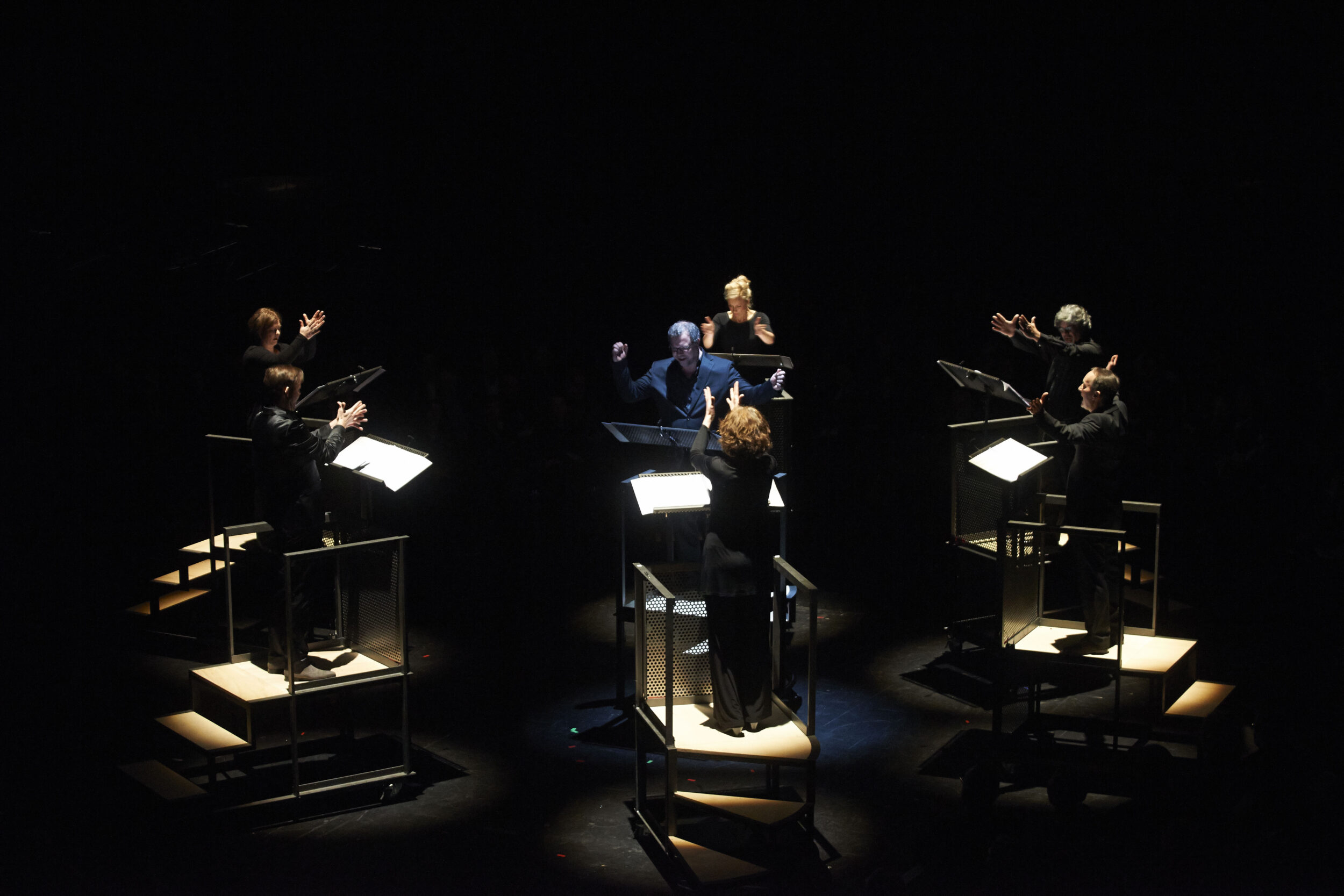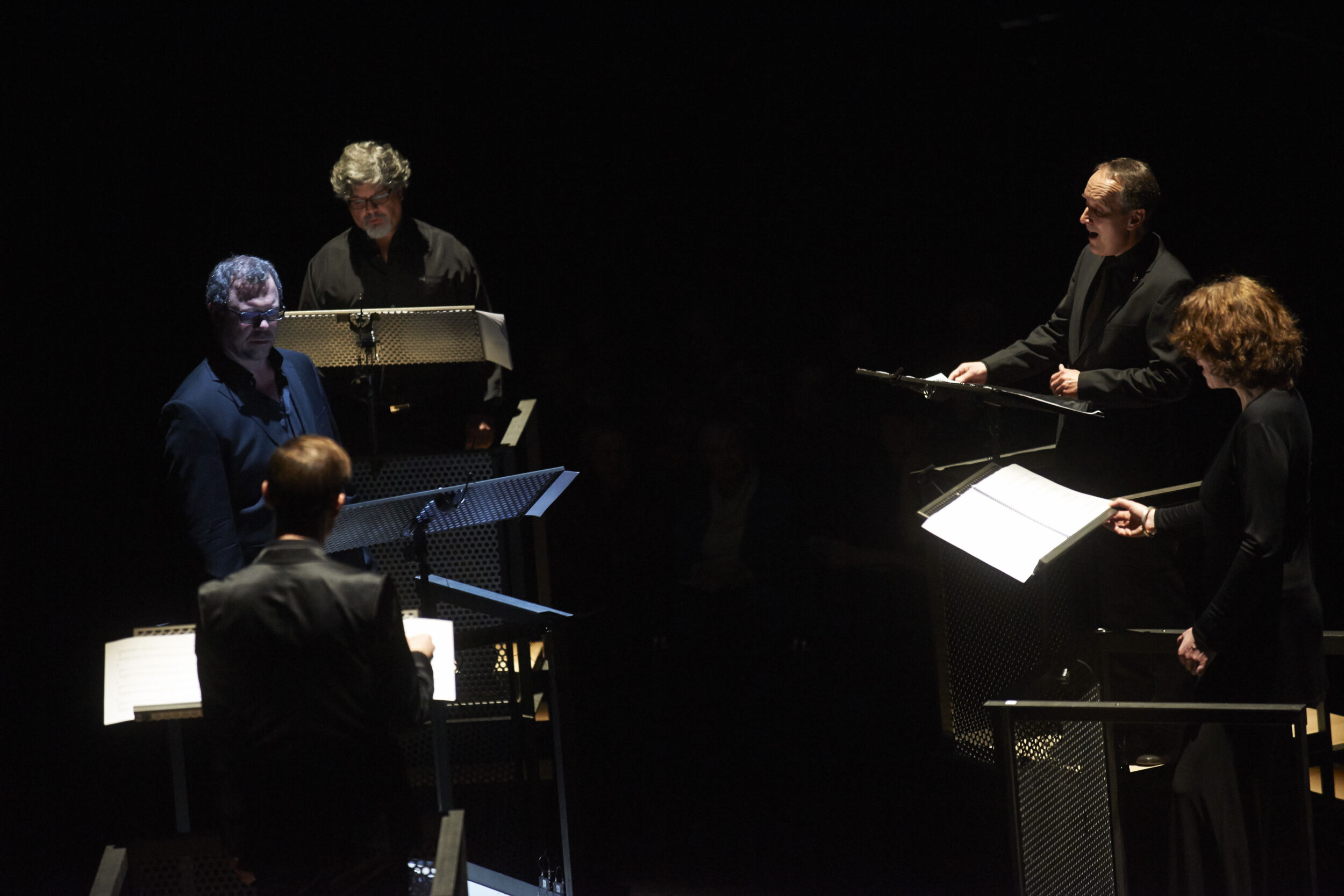Evis Sammoutis: Sculpting Air
for five voices
(2013/2014)A video-concert-architecture about twelve identities from the Mediterranean region.
Twelve composers from Mediterranean countries have each written a work for the Neue Vocalsolisten. Video artist Daniel Kötter travelled to the twelve countries of origin and captured the different situations of the artists and the regions on video. Architect Sofia Dona designed the architectural framework for the multi-part event.

World Premiere: 9. Februar 2014, Theaterhaus Stuttgart, Festival ECLAT
A production by Musik der Jahrhunderte Stuttgart
Supported by the German Federal Cultural Foundation, the Ernst von Siemens Music Foundation, the Goethe Institute and the Akademie Schloss Solitude
The Mediterranean
A trans-cultural space between three continents, charged with history and myths, the cradle of democracy, the birthplace of three world religions. The space where some of civilization’s most significant achievements—the development of writing, the arts, and philosophy—originated. A space filled with diversity and contradictions, perpetually shaken by power struggles and civil wars. A space where Europe draws its borders. A space in transition, striving for forms of modern society. A place of longing.
The protagonists
The Mediterranean Voices project is an interpretation of the Mediterranean region from the perspective of twelve artists, all of whom are based or rooted in a Mediterranean country. Contemporary music, influenced by a Western, European concept of art, plays little to no role in the cultural life of most Mediterranean countries (this is particularly true since the financial crisis and the collapse of arts funding, even in many Southern European countries). Those who choose to pursue a career as a composer often leave their home country, study in Europe or North America, and many remain there as their professional base. They belong to the intellectual class of their country, whether they live abroad or have returned home. Their situation as artists, balancing professional singularity, critical distance from their country, and deep cultural roots, gives them a unique position—the ability to have a clear, unsparing, insightful, and empathetic view of their homeland. We invited twelve composers from twelve countries between Spain and Egypt, and between Syria and Morocco, to collaborate with the Neue Vocalsolisten, video artist Daniel Kötter, and Greek architect Sofia Dona on a project about the Mediterranean region, creating an artistic space that gives us a sense of the themes and dynamics of this region.
The mediators
Mediterranean Voices is also a project about the voice, which plays a special role in the music of the Mediterranean region, whether in connection with text and poetry, liturgical and Quranic recitation, or archaic singing traditions of various cultures. But the voice also offers a wealth of artistic expression, and many composers from the Mediterranean region have developed a particular affinity for this »instrument.« Over the course of a year, the singers engaged in an intensive dialogue with the twelve protagonists of the project. Three symposia facilitated introductions and artistic exchange, as well as situating the project within the context of societal and artistic themes. Additionally, twelve journeys were undertaken: each singer visited one of the composers in their home country.
The researcher
Video artist Daniel Kötter accompanied the Mediterranean Voices for a year, documenting their discussions and travels with his camera. Together with sound expert Marcin Lenarczyk, he undertook extensive journeys across the Mediterranean region. In addition to the twelve portraits capturing the artistic and cultural contexts of the composers in their home countries, they created a unique artistic and documentary video installation comprising 144 short clips. This installation offers a compelling interpretation of the Mediterranean region from the perspective of an investigative cameraman and artist.
The architect
Greek architect Sofia Dona designed the space for the performances of the music and video installations. She had to strike a balance between poetry and pragmatism, vision and diplomacy. The requirements were complex: How does one design an extensive video exhibition within a concert setting? How does one situate twelve spatially distinct concert pieces within a unified space?
for five voices
(2013/2014)for two sopranos, countertenor, tenor and bass
(2013)pour sept chanteurs
(2013/2014)for five distant voices
(2013/2014)for five voices
(2013/2014)for five voices and five spring tubes
(2013)for three male voices and sound objects
(2013/2014)for six voices
(2013)for four voices and live-electronics
(2013/2014)for five voices
(2013)for three female voices
(2013/2014)for seven voices
(2013/2014)


| {{{ content }}} |
|---|
| {{{ content }}} |
| {{{ content }}} |
| {{{ strings.konzerte }}} | {{{ strings.unterstuetzer }}} | {{{ strings.regulaer }}} | {{{ strings.ermaessigt }}} |
|---|---|---|---|
| 30€ | 22€ | 14€ | |
| 20€ | 12€ | 8€ |
| {{{ strings.festivalpass }}} {{{ strings.beinhaltet_die_konzerte }}} |
{{{ strings.unterstuetzer }}} | {{{ strings.regulaer }}} | {{{ strings.ermaessigt }}}* |
|---|---|---|---|
| 234€ | 172€ | 110€ |